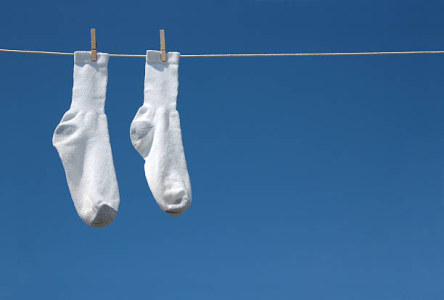Are You Making This Sock-Washing Mistake? Microbiologist Exposes the Shocking Truth—And Why You Should Always Iron Your Socks
By
Gian T
- Replies 14
Let’s be honest—most of us don’t give our socks a second thought. They’re the unsung heroes of our wardrobes, quietly doing their job day in and day out, only to be tossed in the wash with the rest of the laundry and forgotten about until the next wear. But what if we told you that you might be washing your socks all wrong—and that this simple mistake could be putting your health at risk?
That’s right, members! According to Dr Primrose Freestone, a microbiologist from the University of Leicester, your humble socks are a veritable rainforest of bacteria and fungi. And unless you’re washing and caring for them properly, you could be inviting a host of unwanted guests to take up residence on your feet—and even in your home.
You might think that because your socks spend most of their time safely tucked away inside your shoes, they’re relatively clean. Unfortunately, the opposite is true. Our feet are among the dirtiest parts of our bodies, with studies showing that every square centimetre of skin can harbour between 10 and 100 million microbial cells. That’s a lot of tiny critters!
Why so many? Our feet are warm, dark, and humid—basically a five-star resort for bacteria and fungi. Add in the fact that our socks act as 'microbial sponges,' soaking up dirt, sweat, pet hair, dust, and whatever else we walk through, and it’s no wonder they’re a hotbed for germs.
In fact, one study found that after just 12 hours of wear, socks had the highest bacterial and fungal counts of any piece of clothing. Yikes!
So, what’s the big deal? Aren’t most of these microbes harmless? Well, not always. Dr Freestone warns that socks can play host to up to 1,000 different bacterial and fungal species. Some are relatively benign, but others—like Staphylococcus (which causes nasty skin infections), Aspergillus (a fungus that can lead to respiratory issues), and Candida (the culprit behind thrush and other infections)—can be downright dangerous.
And it doesn’t stop there. Dirty socks can also harbour the viruses that cause verrucas (those pesky, contagious warts) and the fungi responsible for athlete’s foot. If you’re not washing your socks properly, you could be spreading these infections to yourself and others, especially if you walk around barefoot at home.
Here’s where things get really interesting. Most of us wash our socks at the same temperature as the rest of our clothes—usually between 30°C and 40°C. But according to Dr Freestone, that’s not nearly hot enough to kill the hardy microbes that thrive on our feet.
'Washing socks in detergent does help clean them, but I have done lab research which shows that some residual bacteria remain in socks if the wash is not a very hot one,' she explains.
So, what’s the solution? Dr Freestone recommends washing your socks at a minimum of 60°C (that’s 140°F for those who prefer the old scale) with an enzyme-based detergent. The enzymes help detach bacteria from the fibres, while the high temperature kills off the nasties that have made themselves at home.
But what if your washing machine can’t handle such high temperatures? Don’t worry—there’s another trick up your sleeve (or should we say, in your laundry basket): the humble iron.
Using a hot iron—especially with the steam function—can help penetrate deep into the sock fibres, killing off any lingering bacteria, viruses, or fungi. It’s an extra step, but one that could make a big difference to your foot health.
Dr Freestone herself is a convert: 'My own socks get a hot wash with an antibacterial detergent and follow-on hot ironing, and so are sparkly clean—as are my feet!'
We know laundry isn’t the most exciting topic, but a few simple changes to your sock-washing routine could save you a lot of trouble down the track. After all, healthy feet mean happy walks, comfortable shoes, and fewer trips to the doctor!
 Have you ever had issues with smelly socks, athlete’s foot, or other foot-related woes? Do you have any sock-washing tips or tricks to share with the community? We’d love to hear your stories and advice—pop your thoughts in the comments below!
Have you ever had issues with smelly socks, athlete’s foot, or other foot-related woes? Do you have any sock-washing tips or tricks to share with the community? We’d love to hear your stories and advice—pop your thoughts in the comments below!
Read more: How to dry laundry without a dryer when it's cold or wet outside
That’s right, members! According to Dr Primrose Freestone, a microbiologist from the University of Leicester, your humble socks are a veritable rainforest of bacteria and fungi. And unless you’re washing and caring for them properly, you could be inviting a host of unwanted guests to take up residence on your feet—and even in your home.
You might think that because your socks spend most of their time safely tucked away inside your shoes, they’re relatively clean. Unfortunately, the opposite is true. Our feet are among the dirtiest parts of our bodies, with studies showing that every square centimetre of skin can harbour between 10 and 100 million microbial cells. That’s a lot of tiny critters!
Why so many? Our feet are warm, dark, and humid—basically a five-star resort for bacteria and fungi. Add in the fact that our socks act as 'microbial sponges,' soaking up dirt, sweat, pet hair, dust, and whatever else we walk through, and it’s no wonder they’re a hotbed for germs.
In fact, one study found that after just 12 hours of wear, socks had the highest bacterial and fungal counts of any piece of clothing. Yikes!
So, what’s the big deal? Aren’t most of these microbes harmless? Well, not always. Dr Freestone warns that socks can play host to up to 1,000 different bacterial and fungal species. Some are relatively benign, but others—like Staphylococcus (which causes nasty skin infections), Aspergillus (a fungus that can lead to respiratory issues), and Candida (the culprit behind thrush and other infections)—can be downright dangerous.
And it doesn’t stop there. Dirty socks can also harbour the viruses that cause verrucas (those pesky, contagious warts) and the fungi responsible for athlete’s foot. If you’re not washing your socks properly, you could be spreading these infections to yourself and others, especially if you walk around barefoot at home.
Here’s where things get really interesting. Most of us wash our socks at the same temperature as the rest of our clothes—usually between 30°C and 40°C. But according to Dr Freestone, that’s not nearly hot enough to kill the hardy microbes that thrive on our feet.
'Washing socks in detergent does help clean them, but I have done lab research which shows that some residual bacteria remain in socks if the wash is not a very hot one,' she explains.
So, what’s the solution? Dr Freestone recommends washing your socks at a minimum of 60°C (that’s 140°F for those who prefer the old scale) with an enzyme-based detergent. The enzymes help detach bacteria from the fibres, while the high temperature kills off the nasties that have made themselves at home.
But what if your washing machine can’t handle such high temperatures? Don’t worry—there’s another trick up your sleeve (or should we say, in your laundry basket): the humble iron.
Using a hot iron—especially with the steam function—can help penetrate deep into the sock fibres, killing off any lingering bacteria, viruses, or fungi. It’s an extra step, but one that could make a big difference to your foot health.
Dr Freestone herself is a convert: 'My own socks get a hot wash with an antibacterial detergent and follow-on hot ironing, and so are sparkly clean—as are my feet!'
We know laundry isn’t the most exciting topic, but a few simple changes to your sock-washing routine could save you a lot of trouble down the track. After all, healthy feet mean happy walks, comfortable shoes, and fewer trips to the doctor!
Key Takeaways
- A microbiologist has revealed that socks should be washed at 60°C or higher with an enzyme-based detergent, as lower temperatures won’t kill all bacteria and fungi.
- If your washing machine can’t reach a 60°C wash, you should iron your socks with steam to kill any remaining microbes, including the viruses and fungi that cause conditions like athlete’s foot and verrucas.
- Socks quickly collect huge numbers of bacteria and fungi from your feet and the environment, some of which can cause infections such as staph, athlete’s foot, and verrucas.
- Regularly changing your socks and washing them properly is vital to prevent spreading infections, as microbes can survive standard washes and be passed on to others through contaminated socks.
Read more: How to dry laundry without a dryer when it's cold or wet outside








